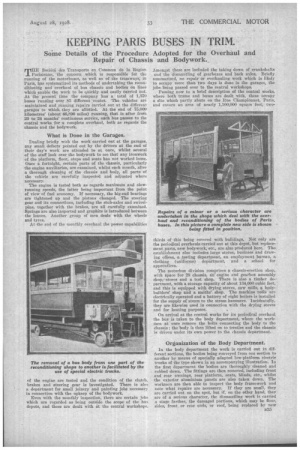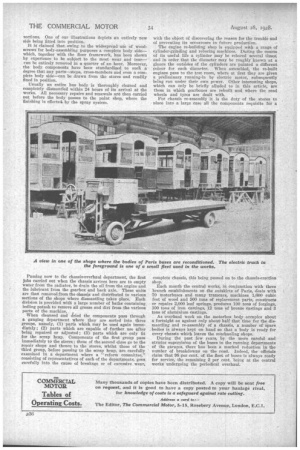KEEPING PARIS BUSES IN TRIM.
Page 19

Page 20

If you've noticed an error in this article please click here to report it so we can fix it.
Soine Details of the Procedure Adopted for the Overhaul and Repair of Chassis and Bodywork.
MHE SocieL6 des Transports en Cotntnun de in Region Parisienne, the concern which is responsible for the running of the motorbuses, as well as of the tramways, in PariS, has systematized its methods of undertaking the reconditioning and overhaul of bus chassis and bodies on lines which enable the work to he quickly and easily carried out. At the present time• the company has a total of 1,370 buses running over 85 different routes. The vehicles are maintained and ruuning repairs carried out at the different garages to which they are allotted. At the end of 75,000 kilometres' (about 46,800 miles) running, that is after from 20 to 24 months' continuous service, each bus passes to the central works for a complete overhaul, both as regards the chassis and the bodywork.
What is Done in the Garages.
Dealing briefly with the work carried out at the garages, any small defects pointed out by the drivers at the end of their day's work are attended to, at once, whilst several of the staff look over the bodywork to see that any ironwork of the platform, floor, steps and seats has not worked loose. Once a fortnight, certain parts of the chassis, particularly the engine auxiliaries, are examined, whilst each month, after a thorough cleaning of the chassis and body, all parts of the vehicle are carefully inspected and adjusted where necessary.
The engine is tested both as regards maximum and slowrunning speeds, the latter being important from the point of view of fuel economy. If necessary, the big-end bearings are tightened up and the pistons changed. The steering gear and its connections, including the stub-axles and swivel. pins, together with the brakes, are all carefully examined. Springs are also inspected and graphite is introduced between the leaves. Another group of men deals with the wheels and tyres.
At the end of the monthly overhaul the power capabilities of the engine are tested and the condition of the clutch, brakes and steering gear is investigated. There is also a department for small joinery and painting jobs necessary in connection with the upkeep of the bodywork.
Even with the monthly inspection, there are certain jobs which are regarded as being outside the scope of the bus depots, and these are dealt with at the central workshops. Amongst these are included the taking down of crankshafts and the dismantling of gearboxes and back axles. Briefly summarized, no repair or overhauling work which is likely to occupy more than two days is done in the garages, the jobs being passed over to the central workshops.
Passing now to a brief description of the central works, where both trams and buses are dealt with, these occupy a site which partly abuts on the Rue Championnet, Paris, and covers an area of nearly 1,100,000 square feet, two thirds of this being covered with buildings. Not only are the periodical overhauls carried out at this depot, but replacement parts, new bodywork, etc., are also produced here. The establishment also includes large stores, business and drawing offieas, a testing department, an employment bureau, a clothing (uniforms) department, and a school for apprentices.
The motorbus division comprises a chassis-erection shop, with space for 28 chassis, an" engine and gearbox assembly shop,stores and a test shop. There is also a timber de-, partment, with a storage capacity of about 134,000 cubic feet, and this is equipped with drying. stoves, saw mills, a bodybuilders' shop and a smiths' shop. The machine toOls are electrically operated and a battery of eight boilers is installed for the supply of steam to the steam hammers. Incidentally, they are likewise used in connection with the drying stoves and for heating purposes.
On arrival at the central works for its periodical overhaul the bus is taken to the body department, where the workmen at' once remove the bolts connecting the body to the chassis ; the body is then lifted on to trestles and the chassis is driven under its own power to the chassis department.
Organization of the Body Department.
In the body department the work is carried out in different sections, the bodies being conveyed from one section to another by means of specially adapted low-platform electric trucks of the type shown in an accompanying illustration. In the first department the bodies are thoroughly cleaned and rubbed down. The fittings are then removed, including front and rear awnings, rear platform, seats, blinds, etc., whilst the exterior aluminium panels are also taken down. The workmen are then able to inspect the body framework and note what repairs are necessary. If they are small, they are carried out on the spot, but if, on the other hand, they are of ft serious character, the dismantling work is carried a stage farther, the damaged portions, which may be floor, sides, front, or rear ends, or roof, being replaced by new
sections. One of our illustrations depicts an entirely new side being fitted into position.
It is claimed that owing to the widespread use of woodscrews for body-assembling purposes a complete body side— which, together with the floor framework, has been shown by experience to he subject to the most wear and tear— can be entirely removed in a quarter of an hour. Moreover, the body components have been standardized to such a degree that any parts—steps, cross-members and even a complete body side—can be drawn from the stores and readily fixed in position.
Usually an entire bus body is thoroughly cleaned and completely dismantled within 24 hours of its arrival at the works. All necessary repairs and renewals aro then carried out before the body passes to the paint shop, where the finishing is effectel. by the spray system.
Passing now to the chassisJoverhaul department, the first jobs carried out when the chassis arrives here are to empty water from the radiator, to drain the oil from the engine and the lubricant from the gearbox and back axle. These units are then removed from the chassis and distributed to various sections of the shops where dismantling takes place. Each division is provided with a large number of baths containing boiling potash to remove all grease and dirt from the various parts of the machine.
When cleansed and dried the components pass through a gauging department where they are sorted into three groups, namely, (1) parts which may be used again immediately; (2) parts which are capable of further use after being repaired or adjusted ; (3) parts which are only fit for the scrap heap. Components of the first group pass immediately to the stores ; those of the second class go to the repair shops and thence to the stores, whilst those of the third group, before passing to the scrap heap, are carefully examined in a department where a "reform committee," consisting of representatives of each of the departments, goes carefully into the cause of breakage or of excessive wear, with the object of discovering the reason for the 'trouble and of preventing its occurrence in future production.
The engine re-building shop is equipped with a range of cylinder-grinding and reboring machines. During the course of its useful life a cylinder may be rebored several times, and in order that the diameter may be roughly known at a glance the outsides of the cylinders are painted a different colour for each diameter. When assembled, the re-built engines pass to the test room, where at first they are given a preliminary running-in by electric motor, subsequently being run under their own power. Other interesting shops, which can only be briefly alluded to in this article, are those in which gearboxes are rebuilt and where the road wheels and tyres are dealt with.
For chassis re-assembly it is the duty of the stores to place into a large case all the components requisite for a complete chassis, this being passed on to the chassis-erection shop.
Each month the central works, in conjunction with three branch establishments on the outskirts of Paris, deals with 70 motorbuses and many tramcars, machines 1,600 cubic feet of wood and 500 tons of replacement parts, constructs or repairs 2,000 leaf springs produces 100 tons of forgingS, 300 tons of iron castings, 12 tons of bronze castings and 3 tons of aluminium castings.
As overhaul work on the motorbus body occupies about a fortnight as against only about) half that time for the dismantling and re-assembly of a chassis, a number of spare bodies is always kept on hand so that a body is ready for every chassis which leaves the overhauling shops.
During the past few years, by the more careful and stricter supervision of the buses in the running departments of the garages, there has been a marked reduction in the number of breakdowns on the road. Indeed, the officials claim that 98 per cent of the fleet of buses is always ready for service, the remaining 2 per cent, being at the central works undergoing the periodical overhaul.
































